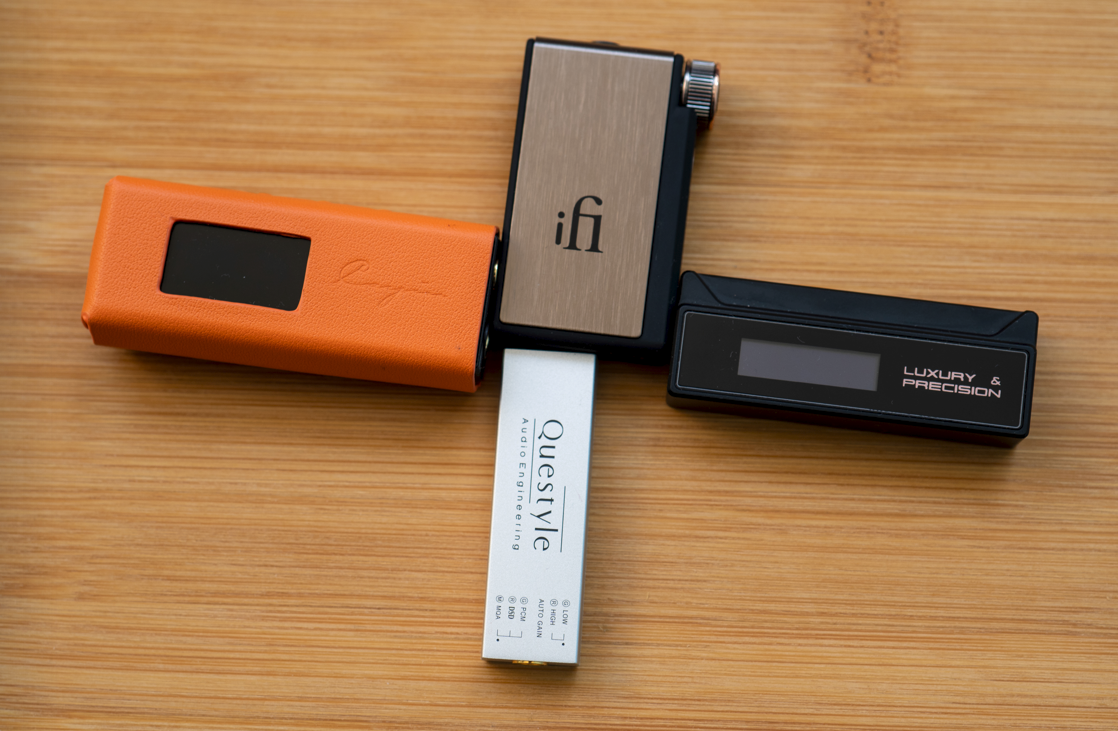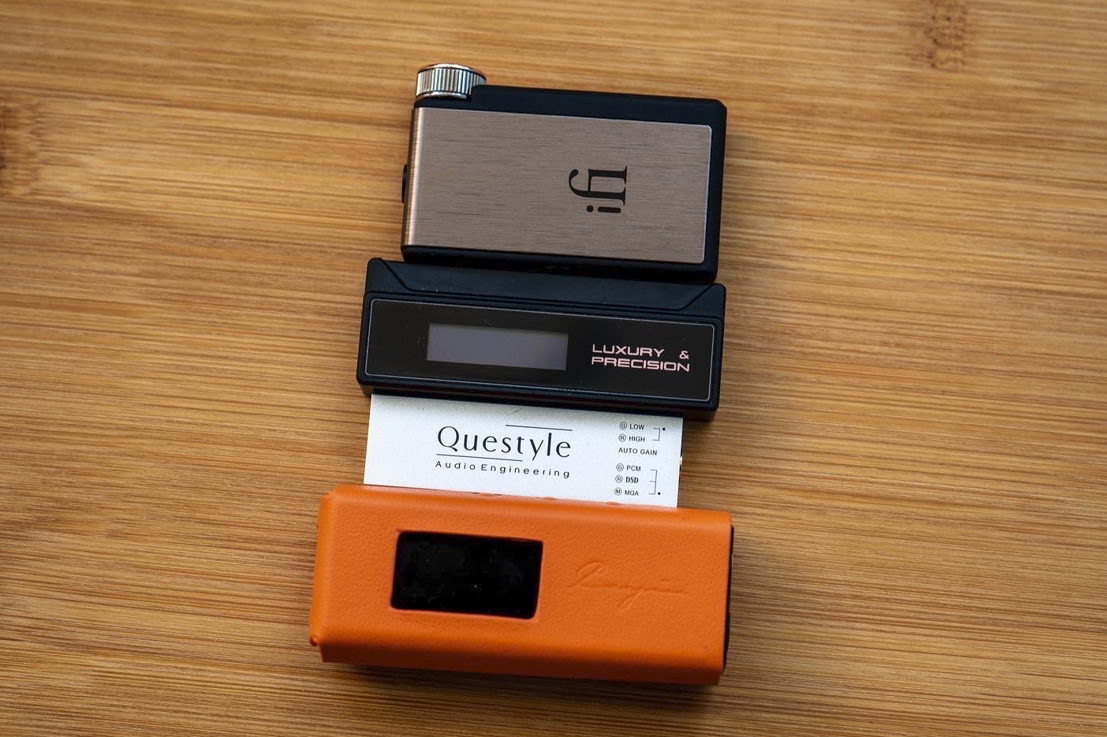The second technological innovation is the Torex high-efficiency power management, which ensures low power consumption without overheating, thus longer battery life and longer playback (5-6 hours).
Based on all the above, M12 comes with really impressive specs: Frequency response 20Hz-20kHz/±0.1dB; THD+N 0.0003%; background noise lower than -130dB; self-adjusting to suite headphones of impedance 8Ω-600Ω; and power 12.26mW at 300Ω. If the detected impedance is less than 70Ω, M12 will self-adjust to low gain output; if it is more than 70Ω, M12 will self-adjust to high gain output; and if it is more than 600Ω, M12 will automatically switch to 2Vrms line out.
The housing of M12 is made of metal (I suspect CNC aluminum) and comes in two colors, black and silver. The quality is absolutely superb, and apparently Questyle in creating M12 miniaturized one of its bigger headphone amplifiers/DACs.
On the front plate there are two lights: A gain indicator for low gain (green) and high gain (red) mode; and a data indicator for PCM (green), DSD (red) and MQA (magenta).
On the other hand, M12 is petite, its dimensions being 51mm x 16.5mm x 8.1mm. It is truly unbelievable that Questyle put so much technology in such a small device. Of course, all these goodies should translate into sound quality, so let’s find out.
Performance
Before I describe the performance of M12, I should mention that all testing was done after I upgraded the firmware (FW) to the latest one 9277; please see
https://questyle-en.oss-us-west-1.aliyuncs.com/Driver/M15 Firmware_v.0427.zip
Now, I am using the word “performance”, because M12 has an amplifier and a DAC section, so I shall comment on each one of the two, and the combined effect is what I call performance.
The main characteristic of M12’s sound is its amazing tonal balance; balanced sound does not mean what some people view as or call neutral sound. One has to be very careful with this term and because of that I very rarely use it. I do not believe that there actually exist neutral sounding products. Truly neutral means no engagement and no musicality whatsoever, so maybe good for studio recording but not for listening to music. M12’s timbre is completely uncolored, and at the same time organic and natural.
The bass is tight, with the right amount of sub- and mainly mid-bass, so you will never feel that M12’s sound is warm and certainly not cold; it is quite interesting that Questyle people succeeded in making M12’s sound organic but not warm, which I have to admit it requires particular tuning skills.
The mids are very natural and relaxing, and both female and male vocals are very nicely presented; never forward or “shouty” and never recessed. I should also note that although the mids are very natural, they never tend to be intimate.
The tremble is extended but never hissing or harsh; so, one gets plenty of details, sometimes even the finest nuances of music, without ever getting tired even after many hours of listening.
The soundstage is great in width, and I was to nitpick an M12 drawback this will be that its soundstage is not that tall and deep. The separation is absolutely great and the image is totally holographic with the musicians and the singer always in the right place.
The dynamics is truly amazing, and M12 is another beast that can drive any IEM or headphone up to 600 Ω where it automatically switches to 2Vrms line out; it appears that the unit has ample power without ever changing its sound signature. Furthermore, M12 is extremely quiet, without any floor noise even with the most sensitive IEMs. Of course, all this is the result of the Current Mode Amplification technology, this unique feature that characterizes all Questyle products, and it is added for the first time to a mobile unit.
Overall, the timbre is totally uncolored, natural, organic, full bodied and transparent, without being euphonic. The resolution is exemplary, with plenty of details, the soundstage is great in width, the separation and image are absolutely top, and the sound is extremely clean. The job Questyle people did in tuning was unbelievable, and to this certainly helps the ultra-low distortion of M12.
The testing of M12 was done with a variety of musical pieces from TIDAL, varying among the classical songs “The Look of Love” by Diana Krall, “Fast Car” by Tracy Chapman, “Over My Head” by Asaf Avidan and “You Don’t Have to Say You Love Me” by Jack Savoretti to mention just a few; Jazz pieces, like “Samba De Orpheus” by Vince Guaraldi; and symphonic pieces like “Fanfare for the Volunteer” by Mark O’Connor. I also used a variety of IEMs and headphones, among them Final A8000 and Pandora Hope VI. In all of them, M12’s performance was completely uncolored, natural, organic, relaxing and transparent, nothing short of outstanding.
I compared M12 to my reference portable DAC/AMP, the Resonessence Labs HERUS+ (an upgrade of the original HERUS that has now discontinued). The HERUS+ uses the ESS Sabre ES9010K2M DAC chip, it has a 1/4 inch output and its MSRP used to be $395.00. On the other hand, the design and implementation of the HERUS+ was done by the people who designed and implemented the ESS chips (Mark Mallinson, the owner of Resonessence Labs, was formerly Director of Operations in ESS), so they took full advantage of the ES9010K2M’s capabilities. The result is a portable DAC/AMP that is made like a tank, it is a pleasure to look at and a bigger pleasure to listen to; its performance is truly stellar. Well, M12 is damn close to HERUS+; the latter is a bit more full bodied and a bit more detailed, but just a bit. I scratched my head why I like so much M12 and now I know: Because its performance is so damn close to that of HERUS+! Can you buy HERUS+ today, and even if you could, would you spend $395.00 on it? The answer is no, but now you know that you have an option: It is called M12!
Conclusion
It is not enough to say that M12 is an amazing unit. You get a petite amplifier with DAC equipped with the Current Mode Amplification module, a truly revolutionary technology used for the first time in a mobile unit. As a result of this and its flagship ES9281AC DAC chip, the sound is totally uncolored, natural, organic, relaxing, transparent, full of details, with great soundstage, top separation and image, and amazing dynamics. On top of all this, M12’s quality is outstanding, the same as in Questyle’s desktop amplifiers.
M12 is probably the best implementation of a a portable amplifier with an ESS chip, and one of the top three DAC/AMPs in the market today. At $139.00 it is a bargain. More than a five star performer!
https://www.questyle.com
Reviewer’s note: The reviewer is grateful to Jamie Zhou of Questyle Audio for sending him a sample of M12.























 But TLDR- Good option under 200 usd range. This is Questyle's cheapest offering and don't expect it to topple their top tier stuff but Questyle's natural charm is still present here. Highly recommended if you are looking for something very very small yet powerful. I am thoroughly enjoying mine
But TLDR- Good option under 200 usd range. This is Questyle's cheapest offering and don't expect it to topple their top tier stuff but Questyle's natural charm is still present here. Highly recommended if you are looking for something very very small yet powerful. I am thoroughly enjoying mine 

